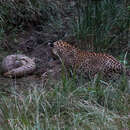pt-BR
nomes no trilho de navegação


Since pangolins resemble armadillos and anteaters in the use of the tongue and the ability to curl into a ball, they were once grouped with them in the order Edentata. They are still called sometimes by their common name of scaly anteaters. Pangolins have been placed in the group Xenarthra.
There is a story of a villager that knocked a pangolin out and brought it back to the village with it around his neck. But the pangolin regained conscience and quickly tried to curl up into a ball. Unfortunately the villager's neck was caught in the middle and he was found strangled to death with the pangolin still wrapped around him.
Perception Channels: tactile ; chemical
It is hunted frequently in Pakistan because some of it's body parts are used for medicinal purposes. Scales are thought of as an aphrodisiac. They are sometimes used to make necklaces. Boots and shoes are made of their skin.
US Federal List: no special status
CITES: appendix ii
IUCN Red List of Threatened Species: near threatened
This species poses no threat to humans.
Manus crassicaudata eat termites that would otherwise destroy crops and buildings.
Manis crassicaudata has a myrmecophagous diet. They mainly eat termites, ants and their eggs, although one Indian pangolin's stomach was reportedly filled with beetle wing sheaths, cockroaches, and skins of worms.
They do not have good hearing or eyesight, instead they rely on their sense of smell to locate the nests of ants and termites. They have 3 main claws that allow them to dig through tough soil. Once they locate and expose the nests their tongues allow them to infiltrate the nest sites with ease. They rapidly "lick" their tongue along the nests as if they were drinking water to catch their prey. Since Manis crassicaudata have no teeth all of the process of "chewing" is done in the stomach. They have a two chambered stomach. One is used for storage, the other which is 1/5 the total size of the stomach is rough and lined with thick muscular tissue. This is the part of the stomach that "chews" and grinds the food before it goes to the intestines.
They prefer several species of prey item, for instance, they might pass up ants and termites under logs in favor of termites in mounds.
Manis crassicaudata is found in India, Nepal, Sri Lanka, and Pakistan.
Biogeographic Regions: oriental (Native )
Manis crassicaudata occupy a variety of habitats. They have been found in tropical rainforests, subtropical thorn forests, plains and the lower slopes of mountains.
Habitat Regions: tropical ; terrestrial
Terrestrial Biomes: savanna or grassland ; forest ; rainforest ; scrub forest
Average lifespan
Status: captivity: 13.0 years.
Average lifespan
Status: captivity: 13.5 years.
Head and body length of Manis crassicaudata can range from 45-75cm, and the tail can be 33-45cm. Males are generally larger than females. The head is small and triangular in shape and the body is slender and long. Manis crassicaudata is covered with about 15-18 rows of tough scales along the dorsal side of its head and body, and about 14-16 rows of scales on its tail. These scales are yellow-brown or yellow-gray in color and made of fused hair. The tough surface protects them from predators, prey, parasites, cold weather, and sharp rocks when they burrow. The scales make up 1/4 to 1/3 of it's body mass. They possess 5 powerful claws on each limb, 3 of which are adapted for digging burrows or locating their prey's nests. They have no teeth. Their tongue, which is 23-25.5cm long, is their main tool for capturing food. It has muscular attachments extending all the way to the pelvis.
Range mass: 5 to 35 kg.
Range length: 45 to 75 cm.
Other Physical Features: endothermic ; bilateral symmetry
Average basal metabolic rate: 6.923 W.
Little is known about the reproduction patterns of Manis crassicaudata. Births have been recorded in January, March, July, and November. The gestation period is between 65-70 days. Females give birth to a single young, and ocassionally two can be produced. Newborns can weigh from 200-500 grams. Their scales are soft, eyes are functional, and can immediately crawl on its own. At about 1 month of age the young are carried on the dorsal base of the mother's tail when foraging, and at about 3 months of age the young are weaned. The longevity of Manis crassicaudata under captive conditions is greater than 13 years. Nothing is known of longevity in the wild.
Key Reproductive Features: gonochoric/gonochoristic/dioecious (sexes separate); sexual
Average birth mass: 350 g.
Average gestation period: 67 days.
Average number of offspring: 1.